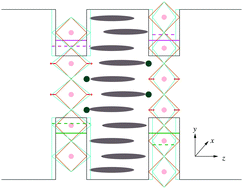Optical deformation potential and self-trapped excitons in 2D hybrid perovskites†
Abstract
Self-trapped excitons (STEs) in two-dimensional (2D) hybrid organic–inorganic perovskites (HOIPs) emit broadband white light, suggesting the great potential of 2D HOIPs in low-cost lighting and display applications. A prerequisite for understanding STEs' properties is a correct identification of the underlying interaction that leads to the STEs. Here, we show that the long-range polar coupling between electrons and optical phonons is quenched in 2D HOIPs' tightly bound excitons and cannot effect STEs. Rather, the STEs are induced by a short-range optical deformation potential (ODP) arising from the phonon-modulated Pb–X quantum-well thickness. Interaction between transition dipoles in adjacent PbX6 (X = Br or I) octahedra gives rise to highly anisotropic intra- and inter-layer exciton bandwidths. In flat (001) 2D HOIPs, both the ODP and the exciton bandwidths are susceptible to out-of-plane PbX6 tilting but not to the in-plane one, and their interplay can quantitatively account for the observed temperature and structure dependences of luminescence associated with STEs. In corrugated (011) 2D HOIPs, the exciton bandwidth is further reduced and the resultant STEs have a stronger lattice distortion and broader luminescence spectrum. Our results reveal the mechanism of STE formation and suggest ways of tuning STEs and associated broadband luminescence in 2D HOIPs.



 Please wait while we load your content...
Please wait while we load your content...